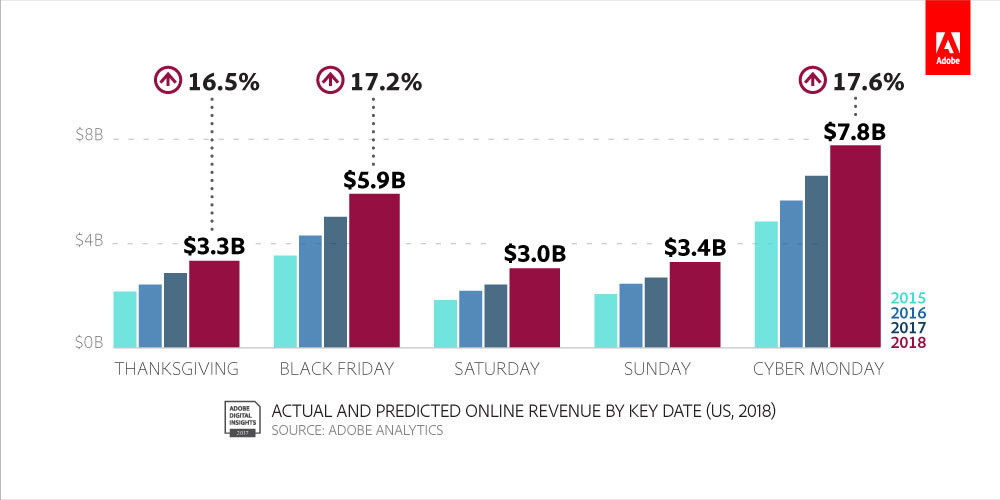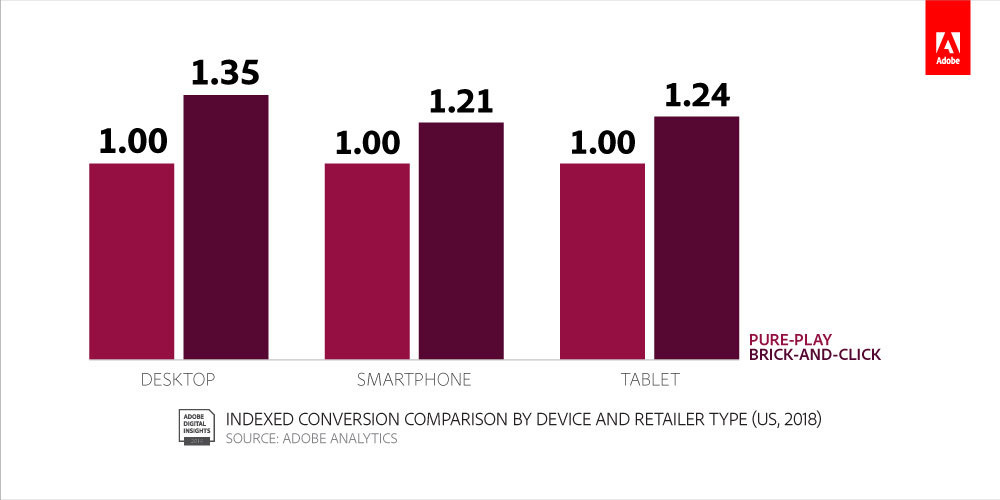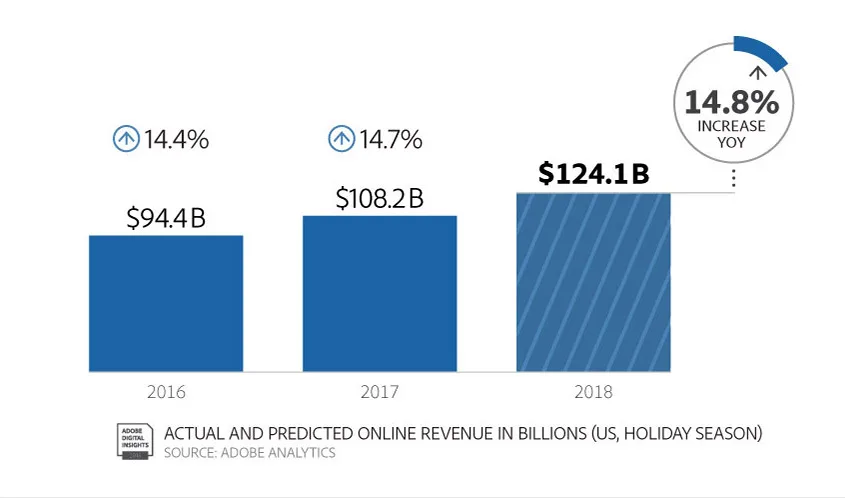Adobe released its online shopping predictions for the 2018 holiday season. Based on Adobe Analytics data, Adobe predicts that U.S. online sales will increase 14.8 percent between Nov. 1 through Dec. 31, totaling $124.1 billion, while offline retail spending is expected to increase only about 2.7 percent.
Cyber Monday will set a new record as the largest and fastest-growing online shopping day of the year with $7.7 billion in sales, a 17.6 percent increase year over year. Online sales between 7 p.m. and 10 p.m. Pacific time on Cyber Monday are expected to drive more revenue than an average full day in 2018, with conversions hitting 7.3 percent, the highest rate of the year.

Thanksgiving Day sales are expected to increase 16.5 percent, generating $3.3 billion. Nearly one out of five dollars this holiday season will be spent between Thanksgiving Day and Cyber Monday, generating $23.4 billion or 19 percent of total online sales.
A record number of days are expected hit new revenue milestones, with 36 days surpassing $2 billion, compared to just 22 days in 2017. Most anticipated gifts include 4K TVs, retro video games and consoles, and toys such as Pomsies, Grumblies, and Fortnite Monopoly.
Retailers with both online and physical footprints are expected to have an advantage, with a 28 percent higher online conversion than retailers lacking a traditional storefront.
Adobe Analytics data anticipates shoppers increasingly buying online and picking up items in-store (BOPIS) during the holiday season. BOPIS has increased 119 percent since January 2018 across all retailers and over 250 percent for large retailers. A survey of more than 1,000 U.S. consumers shows nearly half (47 percent) expect to browse in-store for a product they intend to buy online later, jumping to 58 percent among millennials.

Additional predictions include:
- Top-selling products: Adobe predicts one percent of SKUs will drive a record 70 percent of sales during the holiday season, 30 percent more than during the rest of the year. Top toy predictions include Fingerlings, Fortnite Monopoly, Grumblies, Hatchimals HatchiBabies, Jurassic World Jeep Wrangler, LEGO Harry Potter Hogwarts Great Hall set, and Pomsies.
- Best days for deals: Black Friday reigns supreme for discounts on electronics, including tablets (discounted at 33 percent), TVs (22 percent), and computers (16 percent). On the Sunday before Cyber Monday, shoppers will see the best deals on apparel (22 percent), appliances (18 percent), and jewelry (five percent). Cyber Monday will see the largest discounts on toys (19 percent), Giving Tuesday for furniture and bedding (14 percent), and Thanksgiving for sporting goods (13 percent).
- The mobile revenue opportunity: Smartphones continue to gain share as consumers’ preferred devices for online shopping, representing 48.3 percent of visits and 27.2 percent of revenue. Mobile revenue is up 11.6 percent year over year. Yet, completed cart orders happen over 20 percent less on smartphones than desktop, as a result of abandonment from sub-optimal checkout experiences. This gap equates to $9 billion in mobile sales. Tablets are on the decline, making up 8.8 percent of visits (down 30 percent in four years) and just 9.6 percent of sales. Consumers using mobile apps will spend more time browsing and complete sales two times more often than on the web.
- Emerging shopping trends: Voice-assisted shopping is on the rise, with 21 percent of consumers reporting they are planning to reorder frequently-purchased items and 17 percent placing one-time orders for in-store pickup using their voice activated devices. Adobe expects holiday shoppers to ship and return purchases more often compared to the rest of the year (5 and 18 percent more respectively), and to shop more for experiences like cruises and hotels on Cyber Monday. More consumers will stay home on Thanksgiving Day. Sixty percent report they won’t shop in stores on Thanksgiving Day, up from 40 percent in 2016.
- Top revenue-driving marketing channels: Retailers will be able to capitalize on loyal customers that go directly to their website to make a purchase, with revenue per visit (RPV) rising the most at 36 percent. Search has the second highest RPV growth at 23 percent, followed by helper sites like RetailMeNot (15 percent) and email at 8 percent.
- Social losing value for retailers: Social referral traffic will generate 11 percent less RPV compared to Q4 2016. It is the only marketing channel to see a decline in RPV, despite the increase in referral traffic coming from social. Adobe attributes this to consumers’ weakening trust in social networks. Shoppers are also expected to consult social media sites 25 percent less for gift ideas this year.

